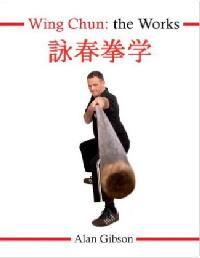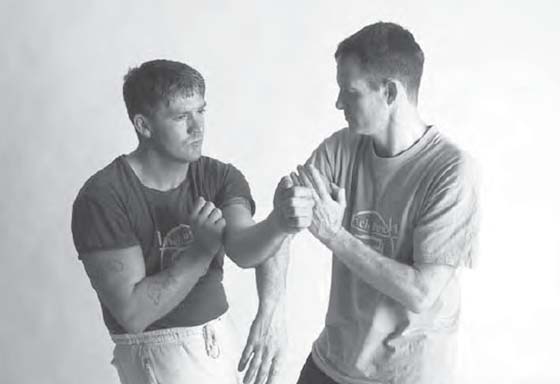
Wing Chun: The Works
November 23, 2014
Self-defence is only an illusion…Wing Chun Kung Fu is a very sophisticated weapon – nothing else. It is a science of combat, the intent of which is the total incapacitation of an opponent.
Wong Shun Leung
 Sifu Alan Gibson lives in Southampton in the UK, one of the more populous areas outside of London, and an area with a pretty decent crime rate (a sister city for Oakland?).
Sifu Alan Gibson lives in Southampton in the UK, one of the more populous areas outside of London, and an area with a pretty decent crime rate (a sister city for Oakland?).
He started studying Wing Chun in the UK, later moving to Hong Kong and studying first with Ip Chun (son of Ip Man), then later, after an encounter with Wan Kam Leung, he switched over to the Wong Shun Leung lineage.
Over the years, he has studied with some of the best of Sifu Wong’s first generation students, including Clive Potter, David Peterson, Cliff Au Yeung, and John Smith.
Wing Chun: The Works is a consolidated and updated version of Alan’s first three books ( Beginning Wing Chun: Why Wing Chun Works , Simple Thinking; Intelligent Fighters , and Wing Chun Forms ).
Reading this book with this review in mind, I had the impulse to quote it in its entirety.

But for me, at this stage in my training, I have found its most useful aspect to be that, aside from being a perfectly clear and concise explanation of the system, it contains descriptions and illustrations of many of the drills handed down to us from Sifu Wong’s classes.
Wong was famous for being able to construct drills on the spot to help develop whatever attribute a particular student might be lacking. Over the years, the drills accumulated, then were pared down, and now the best of the drills have come down to us in the WSL system.
While several of my fellow students in Greg LeBlanc’s school took voluminous notes, I didn’t start writing things down until the last few years (for this blog!).
Fortunately Greg provides excellent (and ever evolving) handouts and notes, but I often forget many of the drills. My training partners and I have occasionally stood around, puzzling over the drills described in the handouts. “Which one is that?”
We’ll try and remember and often we’ll give up and just ask Greg.
Of course, our bodies remember! It only takes a little priming and then my body will slip into the groove laid in previous training sessions.
I resorted to filming some of my classmates doing all the Faak Sau variations, because I could never remember them when I tried to teach them to my own students. They are too intricate to describe in words.
Allan’s book is among other things an excellent compendium of these drills developed more recently by he and his brain trust (of students and other teachers). His descriptions with photos really help jog my memory.
I’m now keeping the book close at hand for use in teaching. He took notes for all of us who neglected to do it in class – thanks Alan!
It felt like we were all part of a collective, a Wing Chun brain, which absorbed information from wherever it could.
Alan Gibson
The other excellent aspect of Alan’s book is its spirit.
Anyone who studies Wing Chun for any length of time has discovered the historical and philosophical debates going on which in many places and among various teachers have become poisonous schisms.
One of the refreshing aspects of Wong’s legacy is his avoidance of most of these politics and his clear and scientific thinking about the system and his personal humility.
Wong declined to call himself Grandmaster and called himself a coach. In regard to the details of the system, he was continually testing and revising it using both logic and challenge matches. His consistent philosophy was one of testing and using what worked and discarding what didn’t work.
This is why he called his approach to the system a “science of in-fighting.”
“I began integrating the ideas of Geoff Thompson and seeing how they could enhance my Wing Chun.”
Throughout Sifu Gibson’s book, we find this spirit of humility and continuing inquisitiveness and innovation and testing alive and well.
We independently found and integrated Geoff Thompson’s ideas, such as the Fence, into our approach to Wing Chun (great minds think alike!).
I really appreciated his discussion on why he left studying under Ip Chun and switched to the Wong Shun Leung lineage.
As someone who also studied under various other lineages before finding a home in Wong’s version of the system, I understand what a mine field this can be. You don’t want to disparage your former teachers and you don’t want to imply you are smarter or better than your former classmates, yet you want to be able to speak about why you chose one over the other or what about the one version your prefer over the other.
When fighting, the Wong Shun Leung system feels closer, more direct and with less emphasis on defending and more on attacking…(and the WSL system) emphasizes the elbow and body structure more…the advantage of this connected structure is that it “feels” more threatening and destabilizing to the opponent’s stance.
Alan Gibson
He ends the book with a series of articles by Dr. Mathew Mills (worth the price of the book alone), with useful advice and info for WC trainees on specifically on how SLT and other forms can act as injury prevention and keep your shoulder’s healthy.
Alan Gibson aslo has a cool website he does on foraging (how to find, store, and prepare wild foods) in his neck of the woods in the UK. I found it very nostalgic – I lived i the UK for nearly five years in the service and I spent a lot of time hiking in their beautiful (and lush!) countryside.
Its called The Urbane Forager .